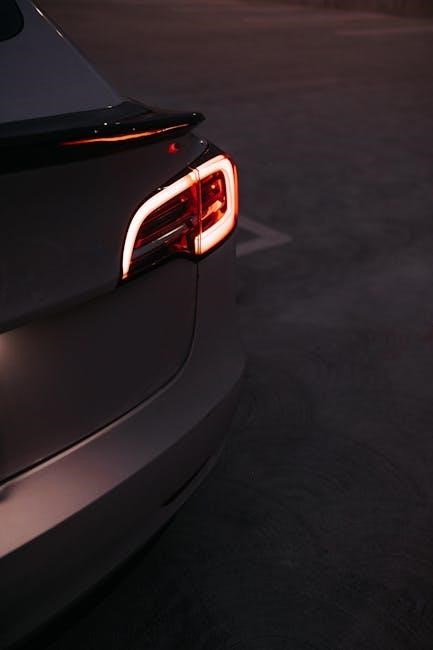The parking brake system is essential for securing your vehicle when stationary, ensuring safety and preventing unintentional movement. Always consult your owner’s manual for specific guidance.
Understanding the Role of the Parking Brake
The parking brake, often referred to as the emergency brake, plays a critical role in vehicle safety and control. Its primary function is to immobilize the vehicle when stationary, preventing unintended movement. This is especially important on inclines or in heavy traffic conditions. Unlike the primary braking system, the parking brake typically operates independently, engaging the rear brakes to secure the vehicle. It is also useful in emergencies, such as brake failure, to bring the car to a safe stop; Proper use of the parking brake ensures safety and prevents accidents. Always refer to your vehicle’s owner’s manual for specific instructions on engaging and disengaging the parking brake effectively.
- Prevents vehicle movement when stationary.
- Acts as an emergency braking system.
- Essential for safe parking on slopes.
Basic Components of the Parking Brake Mechanism
The parking brake mechanism consists of several essential components that work together to ensure proper functionality. The primary components include the parking brake lever or pedal, which activates the system, and the parking brake cables, which transmit the force to the rear brakes. The cables are connected to the brake shoes or pads, which press against the brake drums or rotors to immobilize the vehicle. In some vehicles, an electric parking brake motor is used to automate the process. These components are designed to operate in harmony, providing reliable braking when the vehicle is stationary. Regular maintenance of these parts is crucial to ensure optimal performance and safety.
- Parking brake lever or pedal
- Parking brake cables
- Brake shoes or pads
- Electric parking brake motor (in modern vehicles)

Common Issues with the Parking Brake
Common parking brake issues include failure to engage or disengage, automatic engagement, and stuck brakes. These problems often stem from worn cables, damaged brake shoes, or frozen components.
Addressing these issues promptly ensures vehicle safety and prevents further damage to the braking system.
Why the Parking Brake May Fail to Engage or Disengage
The parking brake may fail to engage or disengage due to worn-out or damaged components; Common causes include frayed or stretched cables, which disrupt the mechanical connection between the lever and brake shoes. Additionally, rust or corrosion on the brake shoes or drums can prevent proper contact. Environmental factors, such as freezing temperatures, can cause cables to seize, making the parking brake inoperable. Improper adjustment of the brake shoes or cables is another frequent issue. Over time, normal wear and tear can lead to these problems, emphasizing the importance of regular maintenance and inspections to ensure reliable functionality.
Causes of Automatic Parking Brake Engagement
Automatic parking brake engagement can occur due to faulty sensors or software glitches in modern vehicles. Moisture or debris in the sensor system may trigger unintended activation. Additionally, extreme temperatures or corrosion in the electrical connections can disrupt the system’s functionality. In some cases, a malfunctioning brake control module or failed actuator may cause the parking brake to engage unexpectedly. Environmental factors, such as exposure to water or humidity, can also lead to automatic engagement by affecting the system’s electrical components. Regular maintenance, including cleaning sensors and inspecting wiring, can help prevent these issues. Always consult your owner’s manual for guidance on troubleshooting and resetting the system.

Troubleshooting Parking Brake Problems
Troubleshooting parking brake issues involves inspecting cables, brake shoes, and sensors for wear or damage. Check for frozen components and ensure proper system lubrication for smooth operation.
Diagnosing Faulty Parking Brake Cables
Diagnosing faulty parking brake cables involves inspecting for wear, fraying, or corrosion. Look for signs of stretching or damage near the cable ends or sheathing. If the cable feels slack or overly tight, it may indicate a problem. Test the parking brake lever or pedal for smooth operation; resistance or sticking suggests a cable issue. Frozen cables due to rust or moisture can prevent proper engagement or disengagement. Always consult your owner’s manual for specific diagnostic steps and safety precautions. If damage is found, replace the cable promptly to ensure reliable braking performance and vehicle safety. Regular maintenance can prevent such issues from arising.
Identifying Worn or Damaged Brake Shoes and Pads
Identifying worn or damaged brake shoes and pads in the parking brake system involves a thorough inspection. Look for visible signs of wear, such as thinning or uneven wear on the pads or shoes. Listen for unusual noises like grinding or squealing when applying the brake, which can indicate damaged or worn-out components. Check the brake’s functionality to ensure it holds the car securely; a loose or ineffective brake may signal worn parts. Inspect the alignment and cleanliness of the brake shoes and pads, ensuring they are free from debris and contamination. Consult your vehicle’s owner’s manual for specific guidance on inspection and maintenance. Regular checks and timely replacements will ensure the parking brake operates safely and efficiently.

Parking Brake Maintenance and Repair
- Clean and lubricate components regularly to prevent corrosion and wear.
- Inspect cables, shoes, and pads for damage or wear.
- Adjust the parking brake system as specified in the owner’s manual.
- Replace worn-out parts promptly to maintain reliability.
Adjusting the Parking Brake for Proper Functionality
To ensure your parking brake operates effectively, regular adjustments are necessary. Begin by consulting your vehicle’s owner’s manual to locate the adjustment mechanism, typically found near the parking brake lever or pedal. Release the parking brake and safely elevate the rear of the vehicle to access the brake components. Remove the rear wheels for clear visibility of the brake shoes and cables.
Tighten the cables gradually, ensuring there’s adequate tension for the brake to hold firmly without being overly rigid. Test the parking brake by pressing the pedal several times to engage any automatic adjusters. If manual adjustment is required, tighten the cables evenly and test the brake’s functionality. Avoid over-tightening to prevent damage to the braking system.
After adjustments, lower the vehicle and test the parking brake on an incline to confirm it holds securely. Check the brake fluid level and inspect for any leaks or damage. Adjustments should be made with caution and patience to ensure safety and reliability.
Replacing Damaged or Worn-Out Components
Replacing damaged or worn-out parking brake components is crucial for maintaining reliable functionality. Start by inspecting the parking brake cables for fraying or stretching. If damage is found, replace the cables entirely. Brake shoes or pads should also be examined for excessive wear; if they are thin or uneven, install new ones to ensure proper contact with the drum or rotor.
When replacing components, ensure all parts are compatible with your vehicle’s make and model. Follow the instructions in your owner’s manual for proper installation. After replacing any parts, engage and disengage the parking brake several times to ensure it operates smoothly. Finally, test the system on an incline to confirm it holds the vehicle securely.
Regular replacement of worn components prevents further damage to the parking brake system and enhances overall vehicle safety. Always prioritize quality parts and precise installation for optimal performance.

Advanced Parking Brake Systems
Modern vehicles often feature advanced parking brake systems, such as electronic parking brakes (EPB), which offer improved functionality and convenience. These systems use electronic controls to automatically engage and disengage, reducing manual effort. They also include diagnostic capabilities to alert drivers of potential issues, ensuring enhanced safety and reliability. Always refer to your owner’s manual for specific instructions on operating and maintaining your vehicle’s advanced parking brake system.
Understanding Electric Parking Brake (EPB) Functionality
The Electric Parking Brake (EPB) is a modern, electronic system designed to secure your vehicle automatically. Unlike traditional mechanical systems, the EPB uses electronic controls to engage and disengage the brakes. When activated, the EPB deploys actuators to apply pressure to the rear brakes, ensuring the vehicle remains stationary. This system offers enhanced convenience, as it eliminates the need for a manual lever or pedal. Many EPBs also feature automatic engagement when the vehicle is shifted into park or comes to a stop, improving safety. Additionally, the EPB often includes diagnostic capabilities to alert drivers of potential issues. Always consult your owner’s manual for specific guidance on your vehicle’s EPB system.
Resetting the Electric Parking Brake System
Resetting the Electric Parking Brake (EPB) system is often necessary after repairs or if the system detects a fault. Begin by consulting your owner’s manual for specific instructions, as procedures vary by manufacturer. Typically, the process involves cycling the ignition, pressing and holding the EPB button, and releasing it after the system resets. Some vehicles require using the dashboard controls to reset the system. If the EPB warning light remains on, additional diagnostic steps or professional assistance may be needed. Always ensure the vehicle is on a level surface and in park before attempting a reset. If issues persist, consult a certified technician to avoid further complications.
When to Seek Professional Help
If your parking brake shows persistent issues like inability to engage/disengage, unusual noises, or warning lights, consult a professional mechanic. Refer to your owner’s manual for guidance.
Recognizing Symptoms That Require Expert Attention
If your parking brake exhibits persistent issues such as inability to engage or disengage, grinding noises, or dashboard warning lights, it may indicate a serious underlying problem. Stuck or frozen brake components, excessive play in the parking brake lever, or automatic engagement without manual input are also concerning signs. If you notice these symptoms, it’s crucial to seek professional help promptly to avoid further damage to the braking system. A qualified mechanic can diagnose and repair issues like faulty cables, damaged brake shoes, or electrical malfunctions in modern systems. Always refer to your owner’s manual for specific guidance on when to seek expert assistance.
